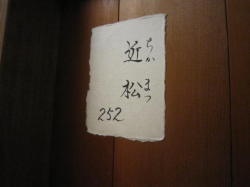 |
The door.
The two Chinese characters are Chika and Matsu.
The Chinese characters are pronounced in some ways.
The temple name Kinshoji can be pronounced Chikamatsu dera. Complicated!
Please enter. |
The entrance room is 4.5 tatami large, and looks like this.
One tatami is 90cm X180cm.
A chest and shelves are installed.
The right space is Tokonoma, which is an alcove where something important
is decorated. |
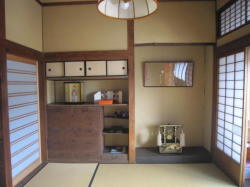 |
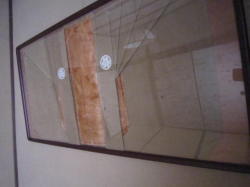 |
This is a costume of a Johruri chanter.
This one was given to me by a Shamisen player who is one of the Japanese
National Living Treasures. |
This beautiful small table is called 'Kendai'. Kendai is a sloped table
on which the chanter put the book when chanting.
I got this Kendai from Takemoto Naruko Dayu, who is the only lady chanter in all Kyushu. She lives in Karatsu, and is trying her best to make Johruri flourish again. |
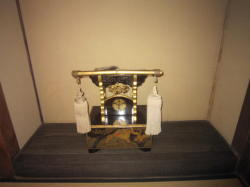 |
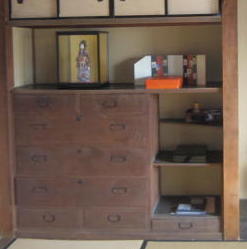 |
The chest is still firm after 100 years. They are empty and guests
can use them.
|
| This small Byobu is a hand dyed attractive one, with the designs
of 12 months' different plays of Johruri. |
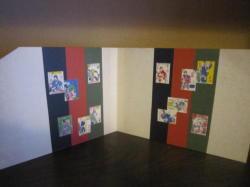 |
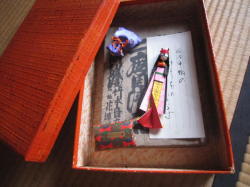 |
In this old letter case, I put three books of Johruri.
Books are almost 150 years old.
Stories are much older. |
| This doll is a heroine of a tragedy. Her name is Osome, one of the
most popular characters who dies together with her loved one.. |
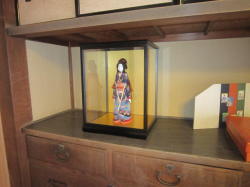 |
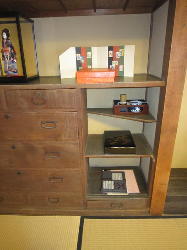 |
Tobacco set on the upper shelf, letter case which holds stationery
for the guests on the middle shelf, and information book of Yoyokaku on
the lowest. |
The bamboo cylinder is the ashtray in old time. A little water was put
inside.
Tobacco was pushed in the mouth of the long pipe, and the porcelain cup
has a small piece of fired charcoal. |
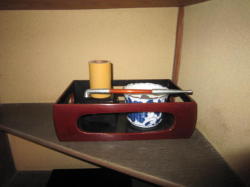 |
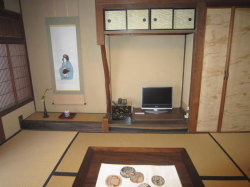 |
Let's step into the main room
6 tatami large. Not very big. It is an ordinally size.
I do not like the modern devices like TV set or telephone, but they are
inevitable for the staying guests. |
The alcove of the main room.
The woman in the scroll is one of the popular heroines, Osono, who is waiting
for her unfaithful husband patiently. |
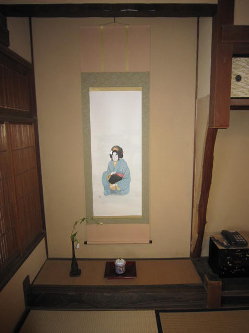 |
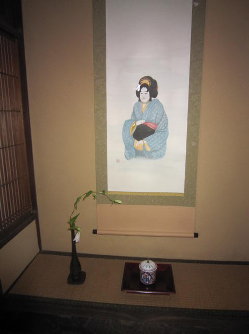 |
For the main character of this room, I searched many antique shops for a scroll with a picture of one of the tragedy heroines, but could not find any.
A friend of mine, Kiyomi Nakashima, who is a traditional Japanese
doll artist, painted this picture of Osono. She said she could not paint,
but I encouraged her to do.
This picture is just what I wanted. Thank you, Kiyomi.
|
A table and chairs are necessary for modern people.
These stools are originally used for Japanese style wedding.
The glass table is a Hibachi, a wooden stove in which we put charcoal in
winter time. |
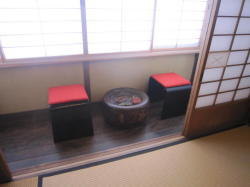 |
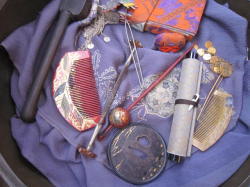 |
I took out the ash from Hibachi, and laid a part of an old kimono and decorated
old accessories like combs, hair ornaments, a part of Samurai's sword (grip
part), etc.
These are more than 100 years too. |
I made a scroll with an old Obi, sash belt for kimono, to hang on the wall.
This is a greeting from Yoyokaku and also an explanation of the room and
decorations. Sword grips are embroidered on this old Obi.This Obi was my
grandmother's belongings.
|
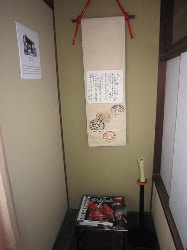 |
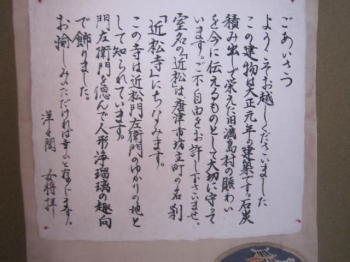 |
Greeting is to explain how old this room is, and why this room is called
Chikamatsu, with the reason of my Johruri decorations.. |
Under the explanation, I put a small table Urushi lacquered and placed
some English books about Bunraku. This table also is more than 100 years
old.
|
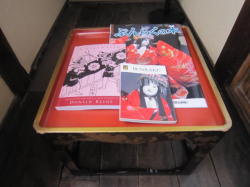 |
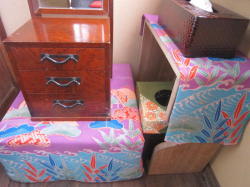 |
On the other side of the hall, there is a mirror.
The cloth underneath the mirror is an old Kimono for a young girl about
100 years ago. Girls of rich family of Edo period must have worn this style
Kimono. |
This tray is to put your clothes when you take them off.
I colored an old ragged tray black, and pasted some pages from an old Johruri
book. Here is another story of human destiny.
|
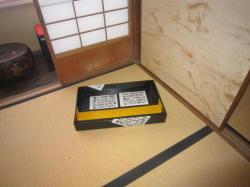 |
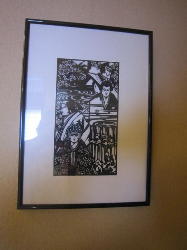 |
On the wall of the wash room, I hang a picture of a historical story
too.
Originally Room Chikamatsu did not have a private toilet. We reformed partially
and made a western style wash room.
I hope many foreign people will stay in this room. |